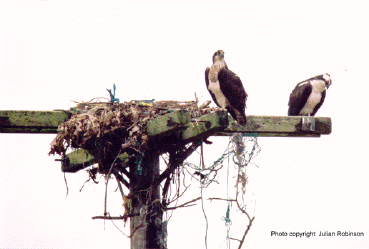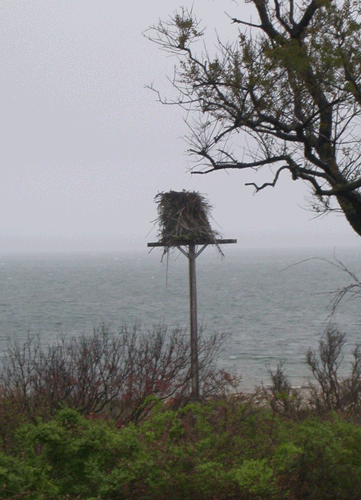Project Osprey Watch - Spring 2003 Newsletter
Contents:
Nesting Success in 2002 (coming soon)
The 2003 Census
An Eagle Scout Counting Ospreys
Satellite Tracking (coming soon)
Elsewhere in New England (coming soon)
![]()
The 2002 Breeding Season
| Following the poor reproductive season in 2001, the Vineyard Ospreys had a good year, with 50 pairs raising 77 young.This was probably our most accurate count of fledging success, because Jim Mason, a UNC-Charlotte graduate student spent three weeks visiting the nests to confirm the number of young raised by each pair. |  |
|
The Felix Neck pair, with the female
(note |
In prior years we were not able to be on the Island for such an extended periodand so in some years when we were up for the August, we may have missed some fledging at early nests. Some of the nests counted as failures in those years might indeed have raised young. In 2001, we were up early and had good counts of the early fledgers, but could not stay around for the end of the season, so in this year we may have overestimated success if some of the nests with young still in them when we left failed to fledge those birds.
Jim's stay on the Vineyard was supported by an anonymous donation, and his housing was generously provided by The Nature Conservancy.
Summary of Productivity-1998-2002
| '98 | '99 | '00 | '01 | '02 | |
| Active nests | 66 | 63 | 63 | 63 | 58 |
| Housekeepers | 4 | 6 | 6 | 4 | 5 |
| Successes |
38 | 41 | 52 | 41 | 50 |
| Fa |
18 | 12 | 8 | 21 | 9 |
| Fledglings: | |||||
| Total | 65 | 64 | 96 | 64 | 77 |
|
Per active nest |
1.16 | 1.21 | 1.6 | 1.03 | 1.33 |
 |
Over Memorial Day weekend, we conducted our annual census of
the 115 poles and two tree nests to count the Vineyard's breeding pairs of
Ospreys.
With two nests not counted (yet) there are 56 pairs on eggs or young this year. The two nests not checked are in remote corners of the Island (Chappy and the south shore). We will be getting reports soon on these nests and suspect they will be active nests. If so, there are exactly the same number of breeding birds this year as last--58. What is different about this year is that there are more "housekeeping" pairs (8) than in any year since we restarted a full census of the Vineyard Ospreys. |
| This year's winner in the biggest-nest competition. This north-shore nest is probably about 5 feet high and easily the tallest nest on the Island. |
Most of the old faithful nests are still occupied, four nests that were used but have been empty for a year or more are reoccupied, and one pole that has long stood vacant has a "starter" nest going. Working our way around the Island from Mink Meadows and Tashmoo, all the old reliables (2 pairs at Mink Meadows and 3 on Tashmoo) are on eggs or young. There is a new nest in a tall pitch pine very close to the Mink Meadows nest. This is probably the pair that built a nest in a pine on the golf course several years ago and then two years ago built on top of the chimney on the Goff house. That chimney was removed in a renovation and the birds have resorted to the old-fashioned way of building a nest--in a tree. We've become so accustomed to seeing Ospreys nest on poles on the Vineyard, that it's easy to forget that Ospreys always used to nest in trees!
Moving down the north shore, the long-occupied nest at Mohu is vacant, while a nearby pole at Paul's Point has a nice starter nest on it, very nicely decorated with some very colorful ribbons from helium birthday balloons. The best-decorated-nest award goes to this pair. Just across the road the new pair that has nested on a power pole for the past couple of years does not seem to be incubating. The Cedar Tree Neck birds are back, as are the birds at Dr. Ganz's (the nest pictured above). Between these two, in Seven Gates, a nest that went unoccupied for several years after one of the adults was electrocuted on a power transformer is active again.
Lots is going on in Chilmark and Aquinnah. The Stonewall Rd. pair is back again, as is the pair overlooking Nashaquitsa. Out on Squibnocket, there is a pair nesting again after a 1 or 2 year hiatus. Michael Straight's nest on Menemsha Pond was blown down in a winter storm. Two pairs of birds were fighting over the pole, with neither able to get a nest started. It's likely that one or both of the breeders here didn't make it back from migration and that this is a couple of young pairs trying to get a territory established. Across the pond, the pair that were housekeeping at James Taylors have upgraded to breeding status, while across the road at the Howland's property overlooking Squibnocket two pairs were fighting over and working on the nest there, but no eggs were laid. It's most likely that at least one of these two pairs were some of the birds seen over at Michael Straight's.
In Gay Heak, AKA Aquinnah, the tall pole at the Menemsha/Squibnocket ponds herring run is once again empty, although it does look like birds have been trying to get a nest started, as they did, unsuccessfully, last year. The Lobsterville pair is on eggs, and, finally, a pair has built a nest on the pole at the Outermost Inn. Once again, several birds were contesting this site. These are housekeepers, which should nest next year if they both make it back from migration. With good reproductive success we have recorded over the past 5 years, it is not surprising that we're starting to see new pairs trying to get established.
There are one housekeeping and three breeding pairs on Chilmark Pond, two breeding pairs in the Quenames-Blackpoint area, and the ever-dysfunctional pair at Big Sandy is doing something, but not breeding. Further up Tisbury Great Pond, the Blue Heron Farm pair is breeding, while across the water Whit Manter's pole is once again empty.
There are no birds on the pole at the Sippiessa boat landing pole, where the nests have failed repeatedly. This is probably a case of a pair setting up their nest with little human activity only to be disturbed as the summer season got going and the boat landing becomes busier. Across Deep Bottom Cove on the Jones farm a pair is nesting again. This is a nest that has a spotty history of occupation with little or no success in recent years.
At least two pairs are nesting on Long Point, with one pole still to check. Moving east, we get to what has become a black hole for Ospreys--the Scrubby Neck/Watcha Pond area. This used to be a thriving colony of Ospreys with six or seven pairs breeding, three of them in quite close proximity. This year there is only one pair here.
Oyster Pond has its usual contingent of three nesting pairs (with one nest very likely to be occupied still to check). Edgartown Great Pond has nine pairs. There's a housekeeping nest at Katama Point, a pair at Ernie Boch's overlooking the llama field and a new pair nesting on Planting Field Way. Four pairs are nesting around Sengekontacket. Hart Haven and the most-seen nest on the Vineyard at the Oak Bluffs Harbor are occupied. Completing the circuit, the Ospreys are back on a power line over the marsh between the Hospital and the Lobster Hatchery.
Chappaquiddick is, as usual, Osprey nirvana. All 10 traditionally occupied nests are busy with eggs or young, including the new pair on a power line off of Litchfield Rd. We have yet to hear from our sources about the nest up at Little Neck/Shearpin Pond.
An Eagle Scout Project
This year our annual fledging count will be coordinated by Duncan Pickard, a student at the MV high school. Duncan is a candidate for Eagle Scout in the local Boy Scout troop and this project will fulfill one of the requirements for his Eagle Scout award. Duncan and the members of his troop will be visiting nests in late July and early August to see how many young the Vineyard Ospreys raise this season and revisiting the nests later in the summer to check and replace predator guards and clear vegetation that has grown up around. Two years ago we lost the young at a nest to a raccoon that climbed up some bushes and got on the pole above the predator guard and want to avoid similar losses in the future.
Satellite Telemetry
As reported last year, the 2001-2002 migration was something of a disaster for the birds we were tracking via satellite telemetry. Of the four birds we were following--the Felix Neck pair and a pair from the south shore, both females disappeared over the Caribbean on their southbound migration, and our old male, HX, did not return from his wintering grounds at the mouth of the Orinoco River in Venezuela. This was the second winter he was wearing a transmitter.
We do not know what happened to "our" birds, but the two that disappeared in the Caribbean landed on boats. We can tell this by the way their signals moved, for several days, through the middle of the Caribbean, where there's no place to perch and the birds won't stop to rest in the water.
HX may simply have been an old bird. Ospreys typically make it into their teens (once they survive the first couple of years, when natural selection takes its toll on around 80% of the young raised in any given year). He may also have been shot, hunters in much of remote South America are often living at subsistence levels and any large animal that can be shot will head for the stewpot.
KC made it through the winter in a different corner of Venezuela and started north on March 20th. Like last year, his departure was very late. The first Ospreys arrived on the Vineyard on March 14th, a full week before KC even started north. Last year he left a day earlier and had to displace a potential usurper of his territory when he got to Martha's Vineyard, some three weeks after he headed north. This year, his trip north was even slower

KC, back late from migration is chased from the sky, bleeding
under his wing, by the new owner of his territory in this dramatic photo, taken
by Vineyard nature photographer Julian Robinson.